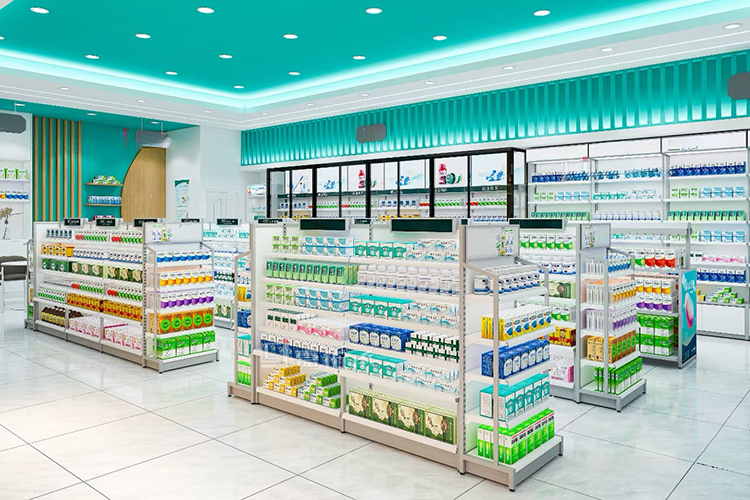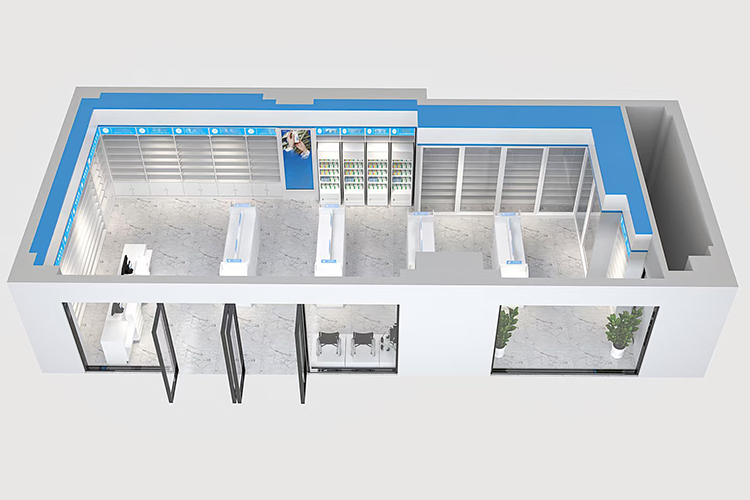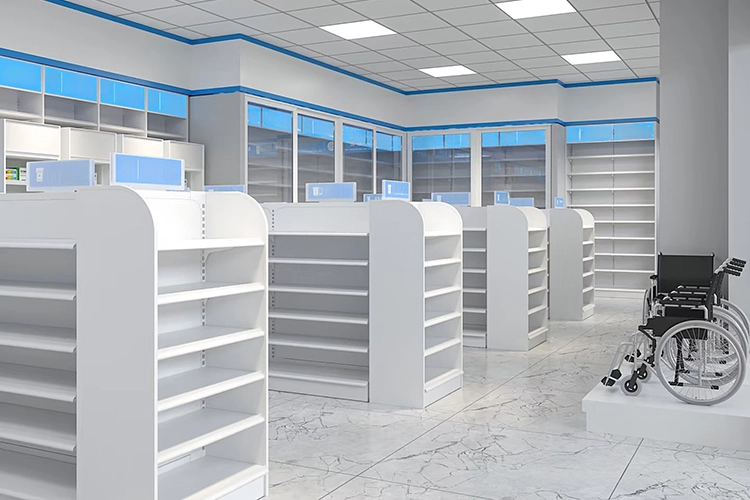
Imagine walking into a medical shop that feels more like a wellness sanctuary than a sterile pharmacy. The warm lighting, natural wood accents, and intuitive layout immediately put you at ease. This isn’t just a place to pick up prescriptions; it’s a space designed to promote health and well-being. Welcome to the future of medical shop design.
In today’s healthcare landscape, the design of medical shops plays a crucial role in patient experience, operational efficiency, and overall business success. This comprehensive guide will walk you through the essential elements of creating a modern, efficient, and compliant medical shop design. Whether you’re planning a new pharmacy or looking to renovate an existing space, this article will provide you with valuable insights and practical strategies.
Pharmacy Interior Design: From Sterile to Welcoming
A Look Back: Traditional Pharmacy Layouts
Historically, pharmacies were designed with a singular focus: dispensing medication efficiently. The typical layout featured long counters, rows of shelves stocked with medicines, and a stark, clinical atmosphere. While functional, these designs often felt impersonal and intimidating to customers.
Current Trends Shaping Modern Medical Shops
Effective pharmacy interior design combines functionality with a welcoming atmosphere, transforming the traditional sterile environment into a space that promotes wellness and comfort. Let’s explore the key trends driving this evolution:
- Integration of Wood and White Color Palettes: The shift from clinical all-white interiors to warmer tones has been significant. Natural wood elements paired with crisp white surfaces create a balance between professionalism and comfort.
- Wellness-Focused Atmosphere: Modern medical shops are designed to feel more like health and wellness destinations. This approach includes creating spaces for health consultations, wellness products, and even areas for health education seminars.
- Technology Integration: From digital signage to automated dispensing systems, technology is seamlessly incorporated into the design to enhance both the customer experience and operational efficiency.
Optimizing Pharmacy Layout for Efficiency and Customer Experience

A well-planned pharmacy layout is crucial for optimizing workflow, enhancing customer experience, and ensuring compliance with regulatory standards. Let’s break down the key components:
Understanding Customer Flow and Behavior
The layout should guide customers naturally through the space, from entry to checkout. Consider these factors:
- Clear Sightlines: Ensure customers can easily locate key areas like the prescription counter, OTC sections, and consultation rooms.
- Intuitive Pathways: Design wide, unobstructed aisles that lead customers through different sections logically.
- Strategic Product Placement: Position high-demand items in easily accessible areas, encouraging impulse purchases while maintaining a smooth flow.
Balancing Aesthetics with Functionality
While creating an appealing space is important, it shouldn’t come at the cost of functionality. Here’s how to strike the right balance:
- Modular Fixtures: Use flexible shelving and display units that can be easily reconfigured as needs change.
- Dual-Purpose Elements: Incorporate design elements that serve both aesthetic and functional purposes, such as attractive storage solutions or decorative privacy screens.
- Brand Integration: Weave your brand colors and elements throughout the design in a subtle, cohesive manner.
Accessibility and Inclusivity in Design
Ensuring your medical shop is accessible to all customers is not just a legal requirement; it’s a cornerstone of good design. Consider these aspects:
- Wide Aisles: Allow enough space for wheelchair users to navigate comfortably.
- Adjustable-Height Counters: Accommodate customers of different heights and those using mobility devices.
- Clear Signage: Use large, high-contrast text and incorporate braille where appropriate.
Small Retail Pharmacy Design: Maximizing Space and Functionality

Small retail pharmacy design requires creative solutions to maximize space utilization while maintaining a comfortable and efficient environment for both staff and customers. Here are some strategies to make the most of limited space:
- Vertical Storage: Utilize wall space with floor-to-ceiling shelving units, ensuring frequently accessed items are within easy reach.
- Multi-Functional Areas: Design spaces that can serve multiple purposes. For example, a consultation room could double as a vaccination area during flu season.
- Smart Product Grouping: Organize products by health concerns or usage rather than brand, making it easier for customers to find what they need quickly.
- Compact Dispensing Area: Optimize the prescription filling area with efficient workflows and compact, automated systems to save space without sacrificing productivity.
- Mobile Point-of-Sale: Consider portable checkout devices to free up counter space and allow for flexible customer service locations within the shop.
Modern Pharmacy Counter Design
Modern pharmacy counter design focuses on creating an inviting first impression while facilitating smooth transactions and maintaining patient privacy. Here’s how to achieve this balance:
Workflow Optimization
- Ergonomic Design: Ensure counters are at a comfortable height for both staff and customers, reducing strain during long work hours.
- Integrated Technology: Incorporate built-in screens for patient information and inventory management, keeping the counter clutter-free.
- Designated Zones: Create separate areas for drop-off, pickup, and consultation to streamline the process and reduce wait times.
Privacy Considerations
- Modular Privacy Screens: Use adjustable dividers that can be moved or removed as needed to create private consultation spaces at the counter.
- Sound-Absorbing Materials: Incorporate materials that reduce sound travel, ensuring sensitive conversations remain confidential.
- Discrete Waiting Areas: Design waiting spaces that offer some privacy, such as individual seating nooks or strategically placed plants as natural dividers.
Key Elements of Medical Shop for a Wellness-Focused Atmosphere
Creating a wellness-focused atmosphere in your medical shop goes beyond just aesthetics. It’s about crafting an environment that promotes health and well-being. Here are key elements to consider:
Color Psychology in Healthcare Environments
Colors can significantly impact mood and perception. In medical shop design, the right color palette can create a calming, trustworthy atmosphere:
- Wood and White Palettes: Combine warm wood tones with clean whites to create a balance between natural comfort and clinical cleanliness.
- Accent Colors: Use calming blues or energizing greens strategically to guide customers and create visual interest without overwhelming the space.
Lighting Design Strategies
Lighting plays a crucial role in creating a welcoming environment and supporting various tasks within the pharmacy:
- Transition from Harsh to Warm Illumination:
- Use a combination of ambient, task, and accent lighting to create a layered, inviting atmosphere.
- Incorporate natural light where possible to enhance the overall feel of the space.
- Task Lighting for Work Areas:
- Install focused, adjustable lighting at prescription counters and consultation areas to support accurate work.
- Use cooler color temperatures in these areas to promote alertness and precision.
Materials and Finishes Selection
The choice of materials can significantly impact both the look and functionality of your medical shop:
- Durability and Cleanliness Considerations:
- Opt for non-porous surfaces that are easy to clean and maintain, such as quartz countertops or vinyl flooring.
- Choose antimicrobial materials for high-touch areas to promote hygiene.
- Creating a Welcoming Atmosphere with Natural Elements:
- Incorporate natural textures like wood grain or stone to add warmth and visual interest.
- Use plants or green walls to bring life into the space and improve air quality.
Technology Integration in Medical Shop Design

Successful medical shop design integrates aesthetic appeal with practical considerations, creating a space that not only looks good but also functions efficiently and complies with industry regulations. Technology plays a key role in achieving this balance:
Digital Signage for Health Information and Promotions
- Install digital displays to showcase health tips, product information, and current promotions.
- Use interactive touchscreens for self-service options like refill requests or health risk assessments.
Automated Dispensing Systems
- Implement robotic dispensing systems to increase accuracy and efficiency in prescription filling.
- Use automated storage and retrieval systems to maximize space utilization and improve inventory management.
Inventory Management Technology
- Integrate RFID technology for real-time inventory tracking and automated reordering.
- Use smart shelving systems that can detect low stock levels and alert staff.
Cybersecurity for Patient Data Protection
- Design secure, enclosed areas for computer systems handling sensitive patient information.
- Implement physical security measures like privacy screens and secure access points to protect digital assets.
Regulatory Compliance in Medical Shop Design
Adhering to regulatory standards is crucial in medical shop design. Here are key areas to focus on:
USP 797 Standards for Sterile Compounding Areas
- Design clean rooms with proper air filtration and pressure differentials.
- Include anterooms for proper gowning and hand hygiene.
USP 800 Requirements for Handling Hazardous Drugs
- Create separate storage areas for hazardous drugs with proper ventilation.
- Design dedicated spaces for preparing and administering hazardous drugs.
HIPAA Compliance in Design
- Implement sound-dampening materials in consultation areas.
- Design prescription pickup areas that ensure patient privacy during transactions.
ADA Compliance
- Ensure all areas are accessible, including wide aisles and lowered counters where necessary.
- Install proper signage and tactile guidance systems for visually impaired customers.
Sustainability in Medical Shop Design
Incorporating sustainable practices in your medical shop design not only benefits the environment but can also lead to long-term cost savings:
Energy-Efficient Systems
- Install LED lighting with motion sensors to reduce energy consumption.
- Use energy-efficient HVAC systems with programmable thermostats.
Eco-Friendly Material Choices
- Choose sustainable materials like bamboo flooring or recycled glass countertops.
- Use low-VOC paints and finishes to improve indoor air quality.
Waste Reduction Strategies
- Design easily accessible recycling stations throughout the shop.
- Implement digital prescription systems to reduce paper waste.
Case Studies: Successful Medical Shop Designs
Let’s look at some real-world examples of effective medical shop designs:
- Small Retail Pharmacy Transformation:
A 500 sq ft pharmacy in urban Seattle maximized space by using vertical storage, a compact robotic dispensing system, and a flexible consultation area that doubles as a vaccination clinic when needed. - Modern Hospital Outpatient Pharmacy:
A 2000 sq ft outpatient pharmacy in a Chicago hospital incorporated a drive-thru window, digital queuing system, and a spacious wellness product section, resulting in a 30% increase in OTC sales. - Innovative Community Health Center Pharmacy:
A rural health center in Texas integrated its pharmacy with telehealth services, featuring private video consultation booths and a 24/7 prescription pickup locker system, improving medication adherence rates by 25%.
Budgeting and ROI Considerations
Investing in medical shop design can yield significant returns. Here are some considerations:
- Phased Implementation: Start with critical areas like the dispensing counter and gradually update other sections to spread costs over time.
- Technology ROI: While initial costs for automation can be high, calculate long-term savings in labor and increased accuracy.
- Energy Efficiency Payback: Factor in long-term savings from energy-efficient lighting and HVAC systems when budgeting.
Future Trends in Medical Shop Design
As healthcare continues to evolve, so will medical shop design. Keep an eye on these emerging trends:
- Integration of Telehealth Services: Designing private spaces for virtual consultations within the pharmacy.
- Expansion of Point-of-Care Testing Areas: Creating dedicated spaces for rapid diagnostic testing and health screenings.
- Adapting to Changing Consumer Health Behaviors: Incorporating more space for wellness products, nutrition consultations, and preventive health services.
Conclusion
A well-designed medical shop is more than just a place to pick up prescriptions—it’s a cornerstone of community health and wellness. By focusing on creating an efficient, welcoming, and technologically integrated space, you can enhance both the customer experience and your business’s success.
Remember, great design is an ongoing process. Stay attuned to your customers’ needs, keep up with industry trends, and be willing to adapt your space as healthcare continues to evolve. Whether you’re starting from scratch or renovating an existing space, the principles outlined in this guide will help you create a medical shop that stands out in today’s competitive healthcare landscape. If you are still not sure how to design your own shop, contact iYubo. We offer a one-stop customization solution for you!





